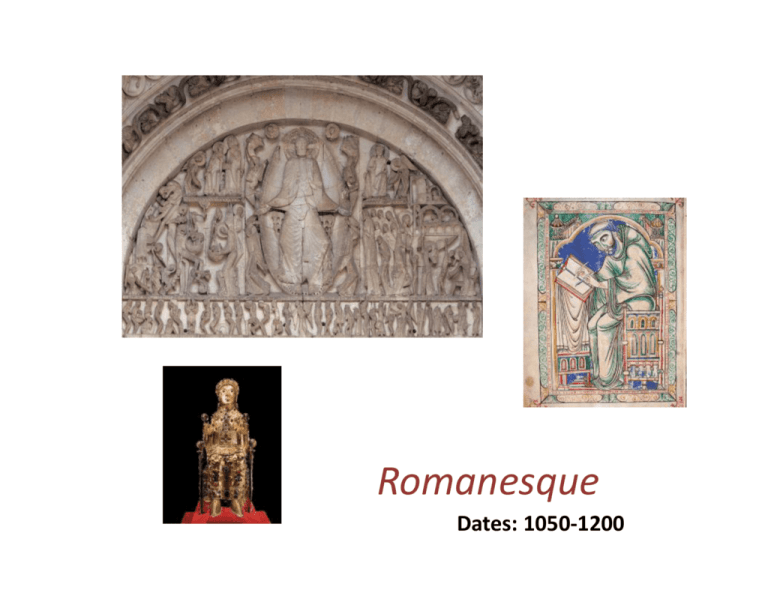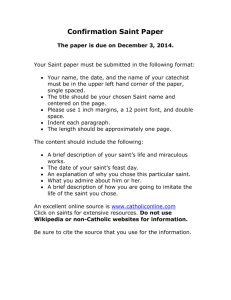Week 8 & 9 - Romanesque
advertisement

Romanesque Dates: 1050‐1200 Europe ca.1100 Romanesque Period • The Romanesque period is marked by: ‐ Immense relief the world hadn’t ended at the turn of the millennium (999/1000 AD) ‐ The resurgence of cities and trade ‐ Strengthened Papal authority ‐ The emergence of a middle/ merchant class ‐ The peak in feudalism as a political system • There was continued growth in monasticism with two prominent orders: ‐ Cluniac ‐ education, music and art. ‐ Cistercian ‐ manual labor and self denial Romanesque Art Style • The Romanesque art style of the Middle Ages was created largely for the Western Christian Church which became known as the Catholic church. • The style of Romanesque Art was characterized by: – The use brightly colored stained glass windows – Illuminated manuscripts – Religious shrines and caskets were decorated with fine metals, gilt work and enamel – Embroidery – Large, stone, figurative sculptures – Murals ARCHITECTURE (1) nave, (2) aisles, (3) choir, (4) ambulatory, (5) radiating chapels. Interior & floor plan of Saint‐Etienne, Vignory, France, 1050‐1057. Roofs Interior & floor plan of Saint‐Etienne, Vignory, France, 1050‐1057. Interior (looking east) of Saint‐Philibert, Tournus, France. Vaults, ca. 1060. Timber roofs were susceptible to fire. In the 9th and 10th centuries looters famously torched many. Concrete construction was forgotten, but cut stone was developed, and became the main technique. Vaults Arched ceiling or roof, usually in brick or stone Groin vault – a vault produced by the intersection of two barrel (tunnel) vaults. Sometimes the arches of groin vaults may be pointed instead of round Barrel vault – a vault that has a semi‐cylindrical appearance Interior of St. Madeleine Vézelay, France, 1120‐1132 Groin vault Interior (looking east) of Abbey Church, Saint‐Savin‐sur‐Gartempe, 1060‐1115 Barrel vault Relics & Churches • Churches were sanctified and the relics of the saints would be placed within the high altars and reliquaries. • Because many of these churches were placed upon ancient power places recognized for their healing influence, incidents of healing continued to occur. (think of San Juan Bautista, Baños de Cerrato, Spain, 661) • The Christian authorities attributed these healing incidents to the power of the saints' relics and perpetrated the idea that relics and personal possessions of the saints exuded a mysterious essence which granted requests to prayers and other miracles. • Consequently the era of medieval pilgrimages began. Pilgrimage & Churches • Pilgrimages had been an aspect of Christianity from as early as the 4th century when Helena, who had supposedly found the ‘True Cross’ in Jerusalem. • It was not until the 9th century discovery of the relics of St. James in Compostela, Spain, and the enormous influx of relics following the 11th and 12th century Crusades that European Christian pilgrimages really began. – These relics resulted in a 400 year period of religious fervor took hold of people's minds. Finding of the true cross by St Helena. Illustration from MS CLXV, Biblioteca Capitolare, Vercelli, a compendium of canon law from Northern Italy, ca. 825 Pilgrimages • To understand the enormous popularity of pilgrimages during this period, it is necessary to recognize the forces which had been shaping people's minds for many hundreds of years. • The entire medieval period, beginning in the 6th century, had been a time of relentless war, abject poverty, devastating famine, near total illiteracy and ignorance. – Infant mortality was high, life expectancy was low, and medicine was almost non‐existent. – Life was difficult‐ even for the nobility. Saint James, Santiago de Compostela Cathedral and rear view ca. 1075–1120 Saint James (1st c AD), brother of Saint John the Evangelist, was sentenced to death by beheading to appease religious protests and to punish the Christian community. He was the first apostle to be martyred. St. James, Santiago de Compostela • According to tradition, James’s followers took his body back to Spain for burial and buried his body in a field that was shown to them by the light of a very bright star. Later a church was built on the burial spot and the resulting settlement was named Santiago de Compostela. • In the mid 9th century, a hermit discovered a stone tomb with the remains of Saint James and two of his disciples, Theodore and Athanasius. – Since then, Santiago has been a place of great devotion and a site of pilgrimage. – It is said that in the Middle Ages one tenth of the population of Europe was on its way to Santiago. Interior (looking east) of Saint James, Santiago de Compostela, Spain, ca. 1075– 1120. St. Sernin, Toulouse • The first Bishop of Toulouse was Saturninus, who in 250 AD met a violent death for refusing to worship pagan gods. Roped to a sacrificial bull by mobs gathered on the steps of the Capitoline Temple, St. Sernin was dragged down the main street of Toulouse to his death. • The saint's body was buried by the local Christian community outside the city walls. The first shrine on the present site, a little to the north of his original tomb, was built ca. 400‐03 by Bishop Exupere. • The relics of St. Sernin attracted many pilgrims from the start, but visitors really began to pour in with the rise of the pilgrimage to Santiago de Compostela in the early 11th century. – Toulouse is along a main route to the Spanish shrine. Aerial view (looking northwest) of Saint‐Sernin, Toulouse, France, ca. 1070–1120. Interior & plan of Saint‐Sernin, Toulouse, France, ca. 1070‐1120 Sainte‐Foy, Conques • The pilgrimage routes that passed through smaller shrines along the way, soon became rich from pilgrim gifts and religious tourism. For the monks at Conques, the lure of fame and riches proved too much to bear, and they conspired to steal some relics to attract pilgrims. Sound familiar? • In 866, a Conques monk was dispatched to join a monastery in Agen, which had the relics of St. Foy, a virgin martyred in 303 AD under Diocletian. The saint was known for her ability to cure blindness and free captives, and her statue‐reliquary attracted many pilgrims. • The Conques brother acted as a faithful monk for 10 years at Agen until he was able to steal the relics, which he brought back to Conques. The saint's mortal remains were placed inside a golden reliquary‐statue by the end of the 9th century. And just as they had hoped, the pilgrim road shifted from Agen to Conques. Shrine‐reliquary of St. Foy, 9th c The Conques monastery soon prospered. Pilgrims left jewels to be added to the saint's statue and the best goldsmiths competed to create ornaments and containers for the relics. Aerial view (looking southwest) of Sainte‐Foy, Conques, France, mid 11th to early 12th century The Martyrdom of… St. Foy St. James St. Sernin Medieval images: painting (left & right) and manuscript (center) Large Relief Sculpture • • • One of the major developments of the Romanesque period was the re‐emergence of monumental figurative sculpture, after several centuries of abandonment. There was a good deal of Ancient art around to serve as models, but fears of idolatry or the charge of idolatry seem to have eliminated the subject during the early Medieval period. But now, monumental figure carving in stone emerged along with stone vaulting. Christ Pantocrator, Sicily BERNARDUS GELDUINUS, Christ in Majesty, relief in the ambulatory of Saint‐Sernin, Toulouse, France, ca. 1096. Marble Christ in Majesty (Maiestas Domini) with apostles, lintel over the doorway of the abbey church, Saint‐Genis‐des‐Fontaines, France, 1019–1020. Marble The image includes the first and last letters of the Greek alphabet, in a reference to his statement as the arbiter of Judgment Day: I am the Alpha and the Omega, the First and the Last, the Beginning and the End. (Rev. 21:6). So this is not only an early figurative piece, but one of the favorite subjects of the era: the Christ of the Last Judgment. Christ Pantocrator (Byzantine) = Christ in Majesty (Medieval) Church Portal A portal is any doorway or entrance but especially one that is large and imposing. In the Romanesque period, the tympanum and the trumeau were usually decorated with figural sculptures. The Romanesque church portal. • The subject was often fate in the afterlife or salvation. • Served as a warning. • Images were stiff and stylized, not natural Subject: Christ in majesty surrounded by angels and 24 Elders (tympanum); Sts. Peter and Paul (door jamb); Jeremiah or Isaiah? (trumeau) Last Judgment, south portal of Saint‐Pierre, Moissac, France, ca. 1115–1135. Restored cutaway view of the third abbey church (Cluny III), Cluny, France, 1088‐1130 Cluny III (11th cent.), was a five‐aisle basilica with double transepts and five radiating chapels around the apse. Towers marked the major and minor crossings of the nave, the major transept arms, and the western facade. When completed in the 12th cent., Cluny III was the largest church in the world. Architectural Elements façade (1) nave, (2) aisles, (3) choir, (4) ambulatory, (5) radiating chapels. Barrel vault – pointed arches Interior of abbey church of Notre‐Dame, Fontenay, France, 1139–1147 Regional Variations Romanesque architecture can be compared to the Romance languages of Europe, which vary regionally but have a common core in Latin, the language of the Romans. • Germany • Lombardy • Normandy • England • Italy Speyer was a bishop’s church and therefore a cathedral. Its timber roof was replaced by groin vaults in 1082‐ 1106. The creation of a set of small clerestory windows sits above the tribune. Clerestory ‐ an upper story of a building with windows above adjacent roofs Interior of Speyer Cathedral, Speyer, Germany, begun 1030; nave vaults, ca. 1082– 1105. Speyer Cathedral St. Michael’s, Hildesheim Norman Romanesque became the major source of French Gothic architecture (emerges in 1140 with the re‐building of St. Denis in Paris.) Façade; the spires were added during the Gothic period. West facade of Saint‐Étienne, Caen, France, begun 1067 The three‐story nave elevation, (predictable by the three‐story façade) opens on a side aisle, a tribune and a strong clerestory. that allows lots of light. Interior of Saint‐Étienne, Caen, France, vaulted ca. 1115–1120. Cross‐inscribed carpet page, folio 26 verso of the Lindisfarne Gospels, from Northumbria, England, ca. 698–721 Durham Cathedral (& castle), England, are tied to Lindisfarne because when monks fled the island from Viking attack in the 9th century, they took the remains of St. Cuthbert, their beloved bishop, with them. Cuthbert’s cross and coffin are on display beneath these vaulted medieval walls which date to 1093. Interior (right) and floor plan (above) of Durham Cathedral, England ,begun ca.1093 Ribbed groin vault. This is the earliest example of the structural system by which we we define Gothic. Romanesque in Italy Cathedral complex, Pisa, Italy, 1063‐1174. Sant’Ambrogio, Milan, Italy, late 11th to early 12th c. The church’s Italian core is recognizable in its three aisle, basilica layout and atrium. It is fronted by one of the latest exterior atriums to come down to us. This combination connects us all the way back to Old Saint Peter’s and the earliest churches. Old St. Peter’s, Rome, ca. 319 Aerial view of Sant’Ambrogio, Milan, Italy, late 11th to early 12th century Interior of Sant’Ambrogio, Milan, Italy, late 11th to early 12th century The interior is constructed around the groin vault. We find them over every bay of the atrium and the interior. The groin vaults over the nave here are ribbed groin vaults. The white marble structures in the field at Pisa are one of the best sites to survive from Medieval Europe. Cathedral complex, Pisa, Italy; cathedral begun 1063; baptistery begun 1153; campanile begun 1174. The simple, central planned, octagonal shape appears to be a conscious attempt to build on the model of the Pantheon, Sta. Constanza and/or San Vitale in Ravenna. Encrustation ‐ geometric ornamental designs and representations of the elements of architectural orders; made of marble. It is a Tuscan characteristic that traces back to Roman times. Baptistery of San Giovanni, Florence, Italy, dedicated 1059 Pantheon, Rome, 126 Baptistery, Florence, 1059 Sta. Constanza, Rome, 4th c San Vitale, Ravenna, 546 The interior ceiling is still a traditional timber one. The flat walls are emphasized by encrustation of geometric forms. With the exception of the apse half‐dome, there are none of the usual vaulted forms we find in other Romanesque structures Interior of San Miniato al Monte, Florence, Italy, ca. 1062–1090 Interior artworks in Italy Sant'Angelo displays a combination of the Byzantine (Eastern) and Latin (Western) traditions. Sant' Angelo in Formis is important for its well preserved frescoes. These expressively depicted stories are clearly influenced by Byzantine models. Both those done in the portico and on the walls were finished in the second half of the 11th century. The life of Jesus is depicted above the arches in the central nave (right) while on the back wall there is a scene depicting the Last Judgment The church was founded by Benedictine monk Desiderius, who had earlier imported Byzantine artists from Constantinople for the monastery of Monte Cassino. Entombment of Christ, fresco above the nave arcade, Sant’Angelo in Formis, near Capua, Italy, ca. 1085 Entombment of Christ, fresco above the nave arcade, Sant’Angelo in Formis, near Capua, Italy, ca. 1085 Lamentation over the dead Christ, wall painting, Saint Pantaleimon, Nerezi, Macedonia, 1164 Regional Differences • Romanesque has strong regional differences, throughout western Europe, both architecturally and decoratively. • We can see this comparing Saint Sernin, with its abundance of side aisle chapels; Speyer, with its octagonal crossing tower, and Sant’Ambrogio with its long and low like early Christian layout. • Northern churches are much more likely to reach into the air like Saint‐Etienne in Normandy while Italian churches are covered in narrative frescoes. Sculpture General view of the cloister, Saint‐Pierre, Moissac, France, ca. 1100–1115. Relief: limestone Cloister: Part of a monastery; a quadrangle surrounded by covered passages. It connects the domestic parts of the monastery with the church. Christ, Doubting Thomas, and apostles, pier relief in the cloister of the abbey church of Santo Domingo, Silos, Spain, ca. 1090–1100. WILIGELMO, creation and temptation of Adam and Eve, detail of the frieze on the west facade, Modena Cathedral, Modena, Italy, ca. 1110. Marble A narrative of Adam and Eve; It comes from a longer frieze, framed in decorative moldings derived from Roman and Early Christian sarcophagi Lions and Old Testament prophet (Jeremiah or Isaiah?), trumeau of the south portal of Saint‐Pierre, Moissac, France, ca. 1115–1130 GISLEBERTUS, Last Judgment, west tympanum of Saint‐Lazare, Autun, France, ca. 1120– 1135. Marble, 21’ wide at base GISLEBERTUS, Suicide of Judas, historiated capital from the nave of Saint‐Lazare, Autun, France, ca. 1120–1135. GISLEBERTUS, Eve, detail of the lintel of the north portal of Saint‐Lazare, Autun, France, ca. 1120–1135. Stone Pentecost and Mission of the Apostles, tympanum of the center portal of the narthex of La Madeleine, Vézelay, France, 1120–1132 Can you identify the imagery in the tympanum? Central portal of the west facade of Saint‐ Trophîme, Arles, France, mid‐12th century West facade, Notre‐Dame‐la‐ Grande, Poitiers, France, ca. 1130– 1150 Reliquary statue of Sainte‐Foy, late 10th to early 11th century with later additions. Gold, silver gilt, jewels, and cameos over a wooden core Head reliquary of Saint Alexander, from Stavelot Abbey, Belgium, 1145. Silver repoussé (partly gilt), gilt bronze, gems, pearls, and enamel (he was a Pope) Painting & other arts…. MANUSCRIPTS Initial R with knight fighting dragons, folio 4 verso of the Moralia in Job, from Citeaux, France, ca> 1115‐1125. Oink and tempera on vellum Initial L and Saint Matthew, folio 10 recto of the Codex Colbertinus, from Moissac, France, ca. 1100. Tempera on vellum Saint Mark, folio 53 recto of the Corbie Gospels, from Corbie, France, ca. 1120. Tempera on vellum Hildegard receives her visions, detail of a facsimile of a lost folio in the Ruperts‐berger Sciviasby Hildegard of Bingen, from Trier or Bingen, Germany, ca.1150–1179 RUFILLUS, Initial R, folio 224 recto of a Passional, from Weissenau, Germany, ca. 1170–1200 Mouth of Hell, folio 39 recto of the Winchester Psalter, from Winchester, England, ca. 1145– 1155. Tempera and ink on vellum EADWINE THE SCRIBE, Eadwine the scribe at work, folio 283 verso of the Eadwine Psalter, ca. 1160–1170. Ink and tempera on vellum painted nave vault of the abbey church, Saint‐Savin‐sur‐Gartempe, France, ca. 1100. Wall Paintings The subjects were drawn from the first five books of the Old Testament. Here there is a lack of Byzantine influence. The figures are elongated, cross legged and agitated, much like the sculpture of the region. Nave of the abbey church, Saint‐ Savin‐sur‐Gartempe, France, ca. 1100. Pantokrator, Theotokos and Child, angels, and saints, apse mosaic in the cathedral at Monreale, (Sicily) Italy, ca. 1180–1190. Christ in Majesty, apse, Santa María de Mur, near Lérida, Spain, mid 12th century. Fresco








